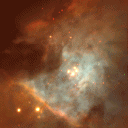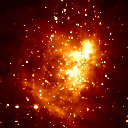

Astronomy 162: Professor Barbara Ryden
Suppose that the edge of a giant molecular cloud is compressed by a shock wave (generated by a nearby supernova, perhaps). A cluster of stars forms from the compressed dark nebulae at the edge of the giant molecular cloud. Hot, luminous stars in the cluster (of spectral type `O' and `B') heat the surrounding gas, causing a shock wave to expand outward. The shock wave compresses more dark nebulae, further inside the giant molecular cloud. A new cluster of stars is formed. The hot stars in the cluster create a new shock wave, which compresses more dark nebulae, which form more hot stars, which create a new shock wave, which compresses more dark nebulae, which....
Well, you get the picture. Once stars start to
form at an edge of a giant molecular cloud, they
trigger a `domino effect'; a wave of star formation
propagates through the cloud. An example of
this effect can be seen in the vicinity of
the Orion Nebula. The Orion Nebula is on
the edge of a giant molecular cloud. When we look
straight at the Orion Nebula at visible wavelengths,
as in the picture below, we see four very hot, luminous
stars within a glowing emission nebula. These stars
are very young -- only a million years old, at most.

However, when we look at the Orion Nebula at
infrared wavelengths (as in the picture below),
we are seeing deeper into the dark and dusty
giant molecular cloud. What we see in this picture
is a large number of protostars in the process of
forming RIGHT NOW.

The protostars began forming when they were shocked
by the hot young stars in the Orion Nebula. The
hot young stars in the Orion Nebula began forming
when they were shocked by the slightly older stars
in Orion's belt (which are about 8 million years old).
The most familiar example of an open cluster is the Pleiades, 117 parsecs (380 light years) away from us in the constellation Taurus. Because the Pleiades are so close to us, they are easily visible to the naked eye. The Pleiades are an open cluster of some 500 stars, in a region 4 parsecs (13 light years) across. (The Pleiades, being quite young, are still surrounded by the gas and dust from which they formed, and hence are in the midst of a reflection nebula.)
An example of a particularly large open cluster is the Wild Duck cluster, about 1600 parsecs (5200 light years) away from us. The Wild Duck cluster (also known by its catalog number, M11) contains about 3000 stars.
Open clusters, since the stars they contain are so loosely packed, are not strongly glued together by gravity. From time to time, a star within the cluster is accelerated to the cluster's escape speed, and is lost to outer space. The open cluster gradually ``evaporates'', as the textbook states the matter. (Just as a glass of water evaporates by losing high-speed water molecules into the air, so an open cluster of stars ``evaporates'' by losing high-speed stars into outer space.) The Sun was probably formed as part of an open cluster of stars. However, since open clusters only last a billion years or so before evaporating, the Sun has long since lost touch with its littermates.
The fact that high-mass stars form more rapidly - and die more rapidly - gives us a method of determining the age of a star cluster.
Consider a very young open cluster, 1 million years old.
Now, consider an older open cluster, 100 million years old.
Updated: 2003 Jan 23
Copyright © 2003, Barbara Ryden